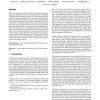Free Online Productivity Tools
i2Speak
i2Symbol
i2OCR
iTex2Img
iWeb2Print
iWeb2Shot
i2Type
iPdf2Split
iPdf2Merge
i2Bopomofo
i2Arabic
i2Style
i2Image
i2PDF
iLatex2Rtf
Sci2ools
APGV
2008
ACM
2008
ACM
Quantifying usability in secure graphics: assessing the user costs of protecting 3D content
There is an increasing need for methods for secure dissemination of interactive 3D graphics content, providing protection for valuable 3D models while still allowing them to be widely shared. Existing systems for protected sharing of 3D models may introduce perturbations into the rendered images of the content, in order to defend against potential malicious reconstruction attacks that could otherwise recover the 3D model shape. However, the particular nature and magnitude of these perturbation defenses has not been based upon any rigorous analysis or measurement of their perceptual effect on non-malicious users of the protected graphics system. In this paper, we take the first steps toward such an analysis, conducting a series of user studies that evaluate the impact (as measured by user reaction time) of varying amounts of noise applied to user interactions in a real-time 3D rendering system. We are thus able to experimentally determine the most appropriate tradeoffs between noise pe...
| Added | 12 Oct 2010 |
| Updated | 12 Oct 2010 |
| Type | Conference |
| Year | 2008 |
| Where | APGV |
| Authors | Jiajun Zhu, Jonathan Z. Bakdash, David Koller, Thomas Banton, Dennis Proffitt, Greg Humphreys |
Comments (0)

